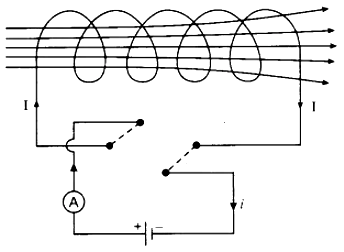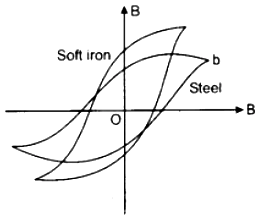Magnetic Hysteresis Curve:
The relation between B and H in ferromagnetic materials is complex. It is often not linear and it depends on the magnetic history of the sample. Figure 8.31 depicts the behaviour of the material as we take it through one cycle of magnetisation. Let the material be unmagnetised initially. We place it in a solenoid and increase the current through the solenoid. (Figure 8.30). The magnetic field B in the material rises and saturates as depicted in the curve Oab. This behaviour represents the alignment and merger of domains until no further enhancement is possible. It is pointless to increase the current (and hence the magnetic intensity H) beyond this. Next, we decrease H and reduce it to zero. At H = 0, B ≠ 0. This is represented by the curve Oc. The value of B at H = 0 is called retentivity or remanence. In figure 8.31, BR ~ 1.2 T, where the subscript R denotes retentivity. The domains are not completely randomised even though the external driving field has been removed. Next, the current in the solenoid is reversed and slowly increased. Certain domains are flipped until the net field inside stands nullified. This is represented by the curve cd. The value of H at d is called coercivity. As the reversed current is increased in magnitude, we once again obtain saturation. The curve Od depicts this. Next, the current is reduced (curve ef) and reversed (curve eb). The cycle repeats itself. Note that the curve Ob does not retrace itself as H is reduced. For a given value of H, B is not unique but depends on previous history of the sample. This phenomenon is called hysteresis.
Ferromagnetic materials can be divided into two categories.

1. Soft ferromagnetic materials
2. Hard ferromagnetic materials

Soft ferromagnetic materials have narrow hysteresis loop. Consequently, they have low retentivity, low coercivity and low hysteresis loss. But they have high relative magnetic permeability. Hard ferromagnetic materials have wide hysteresis loop. Consequently, they have high retentivity, high coercivity and large hysteresis loss.
A study of B-H loops reveals the following informations :
(i) For a given H, B is more for soft iron than steel. So soft iron has a greater permeability.
(ii) As permeability of soft iron is greater than steel, so soft iron has a greater susceptibility than steel.

(iii) The retentivity of soft iron is greater than the retentivity of steel.
(iv) The coercivity of soft iron is less than the coercivity of steel.